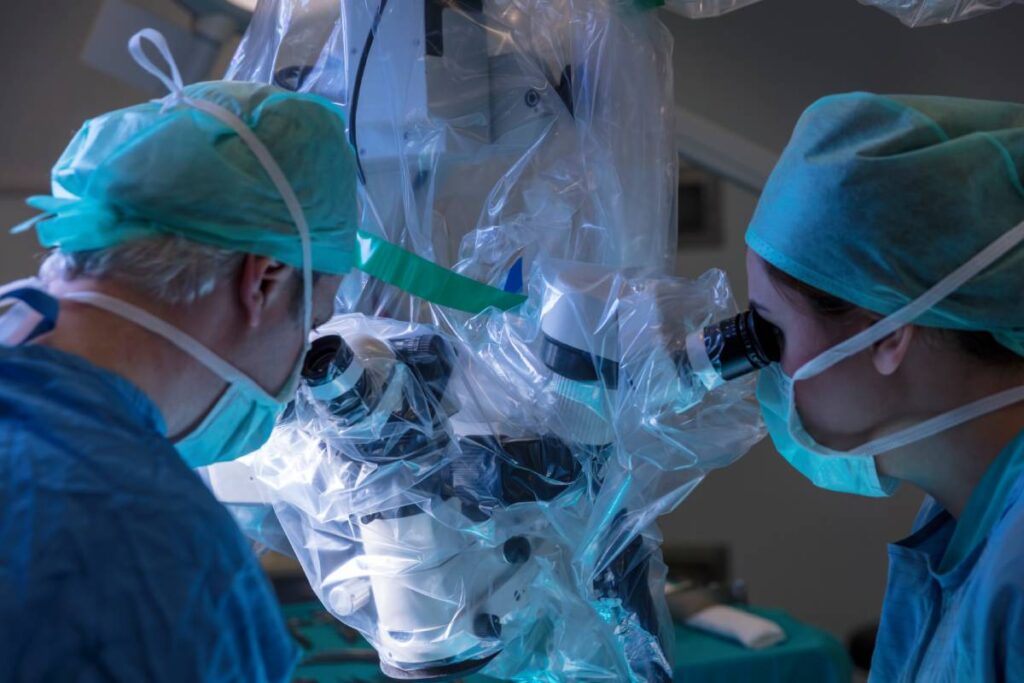Awake brain surgery is a form of craniotomy in which the patient is kept awake during the operation in order to prevent or assess damage to “eloquent” parts of the brain, such as the frontal lobe, temporal lobe, motor cortex, or areas involved in language processing, speech, and memory. A widely used technique for tumor and epilepsy focus resection when the affected domains are within or near these “eloquent” areas, awake craniotomy depends on the active participation of the patient during the procedure to identify essential brain areas, which allows the surgeon to construct a brain map while avoiding damaging healthy tissue. By asking the patient to answer questions or perform simple tasks that depend on nearby brain areas during the craniotomy, the surgeon can preserve these important areas as much as possible while removing the tumor or lesion, therefore achieving maximum resection with minimum functional impairment (1). Although the most common surgical indications for this procedure are resections of tumors in important brain areas (e.g. postcentral gyrus, Wernicke’s and Broca’s areas) and epilepsy focus localization and removal, awake craniotomy can also be utilized for brain biopsy, deep brain stimulation for conditions such as Parkinson’s and Alzheimer diseases, and pain intervention procedures such as thalamotomy (2). Contraindications include neurological deficit, claustrophobia, uncontrolled coughing, obesity, sleep apnea, and highly vascular tumors, as these conditions would complicate or inhibit the objectives of the surgery as well as the patient’s comfort (3).
To achieve active participation but maximum comfort of the patient, a variety of anesthetic techniques are used, depending on the pathology, length of the surgery, patient preferences, and other factors. Despite the use of different medications and airway management techniques, the two most common methods — conscious sedation and general anesthesia with intraoperative awakening — both involve the sedation of the patient during the painful stages of the surgery, which include the incision of the scalp and the removal of the bone flap (2-4). While patients under conscious sedation maintain spontaneous breathing and are stimulated during the surgery by the stopping or slowing of sedatives, patients under general anesthesia are under deeper sedation and receive an endotracheal tube, which is removed in the middle of the procedure (3). In either approach, the mapping and resection phases typically do not include any administration of analgesic medications to enable active patient participation, which can be achieved comfortably due to the lack of nociceptors (pain receptors) in the brain (4).
Regardless of the method, awake brain surgery offers several advantages over the traditional procedure, as demonstrated in a myriad of studies (4-6). In addition to resulting in more effective brain mapping and resection, awake craniotomy also significantly reduces the length of hospital stay, cost of postoperative care, amount of intraoperative vasodepressor, pain, and postoperative nausea and vomiting, mostly due to the lack or minimization of general anesthesia and intubation (4, 5). Moreover, the patients exhibit fewer neurological deficits, longer survival, and higher postoperative satisfaction (5, 6). While complications such as seizures and hypercapnia do occur, they can typically be controlled intraoperatively without any permanent consequences (7). Therefore, due to the significant advantages over traditional craniotomy and minimal disadvantages, awake brain surgery has become the gold standard in neurosurgery for the resection of lesions and tumors in close proximity to “eloquent” areas of the brain.
References
1: Attari, M. and Salimi, S. (2013). Awake craniotomy for tumor resection. Advanced Biomedical Research, vol. 2. DOI: 10.4103/2277-9175.115815.
2: Singh, K. and Dua, A. (2021). Anesthesia for awake craniotomy. StatPearls. URL: https://www.ncbi.nlm.nih.gov/books/NBK572053/.
3: Zhang, K. and Gelb, A. (2018). Awake craniotomy: indications, benefits, and techniques. Colombian Journal of Anesthesiology, vol. 46. DOI: 10.1097/CJ9.0000000000000045.
4: Frost, E. and Booji, L. (2007). Anesthesia in the patient for awake craniotomy. Current Opinion in Anesthesiology, vol. 20. DOI: 10.1097/ACO.0b013e328136c56f.
5: Sewell, D. and Smith, M. (2019). Awake craniotomy: anesthetic considerations based on outcome evidence. Current Opinion in Anesthesiology, vol. 32. DOI: 10.1097/ACO.0000000000000750.
6: Hall, S., Kabwama, S., Sadek, A., Dando, A., Roach, J., Weidmann, C. and Grundy, P. (2021). Awake craniotomy for tumor resection: the safety and feasibility of a simple technique. Interdisciplinary Neurosurgery, vol. 24. DOI: 10.1016/j.inat.2020.101070.
7: Lingzhong, M., Berger, M., and Gelb, A. (2015). The potential benefits of awake craniotomy for brain tumor resection: an anesthesiologist’s perspective. Journal of Neurosurgical Anesthesiology, vol. 27. DOI: 10.1097/ANA.0000000000000179.



